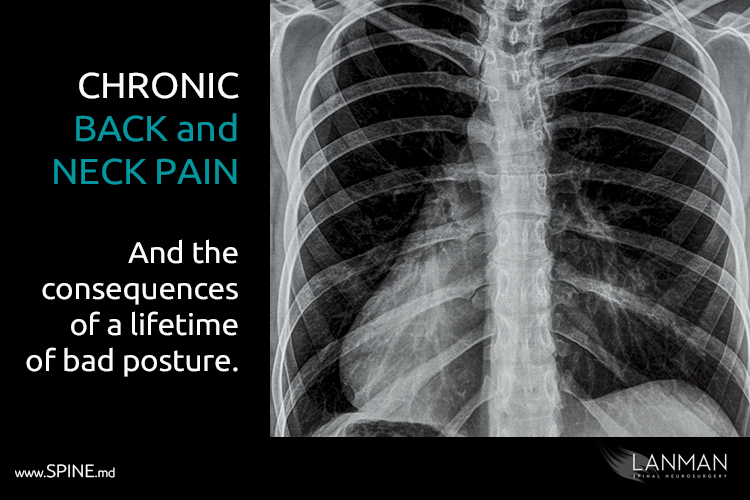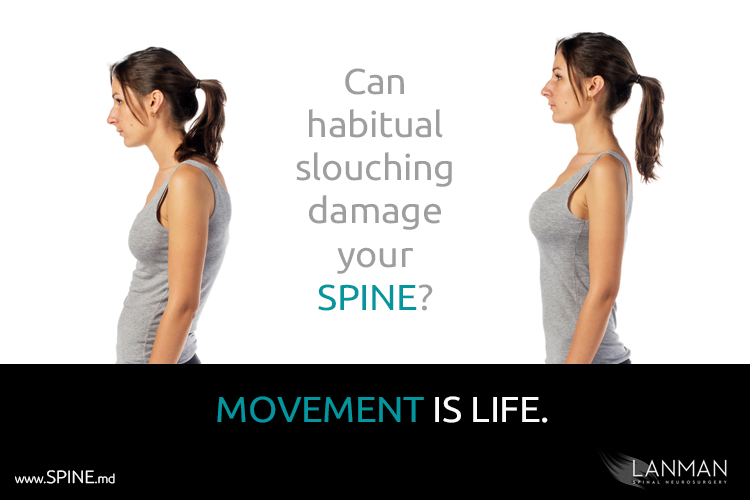As much as you may wince to admit it, your mom was right about your bad posture.
Many of us will eventually develop a little chronic pain somewhere in the body, but more than likely it’ll be your neck or in your lower back. Sometimes both. If your pain isn’t due to a specific injury (e.g., a fall, car accident, sports), then it is probably due to long-term poor posture and genetics (you can thank your parents).
Brace yourself. There’s more.
Your mom was also right if she ever said your future health is having a healthy back or words to that effect. A patient told me that his grandmother said, “When your spine stops moving, so do you.” A mom never spoke truer words. It makes good common sense that taking good care of this complex mass of bone and muscle will pay good dividends all your life.
First, consider the central role of the spine and your whole body. As a surgeon and clinical researcher, I gauge the health of a spinal column regarding the range of motion: anterior flexion, lateral flexion, extension. When you sit in your office chair and turn to get something out of a lower drawer, I see how the individual vertebrae respond to your command so that you can twist and bend your body to reach down and pull the handle. Each bone – each vertebra – is wholly dependent on the correct alignment of every bone before and after it. Consider how two vertebrae move together and flex as one level, and how the force of movement causes the next level to flex.
Now consider the semi-flexible cushions between the bones – the discs – that hold the bones together as a system and prevents the bones from moving too far that they touch or damage the spinal cord and extruding bundles of nerves. Add the muscle, the ligaments, and cartilage that extend the influence of movement on the rest of the muscular-skeletal system: the ribs, shoulders, hips, and head. The fact that we gain such flexibility from this complex assembly is a miracle. Isn’t it worth it to adopt better lifestyle choices to protect it?
Let’s be very honest about our use of personal technology. Laptops, desktop computers, phones, and pads – each type of device has their own set of issues. For instance, just because we call them “laptops” doesn’t mean that we have to crouch over our knees while using them. However, these devices share one thing in common: they force us into the “book reading” posture that adds stress to the upper back and neck. Here’s how:
The average human head weighs about 10 to 12 pounds. Flex it forward in a semi-book reading position (approximately 15-degrees), and the lateral pressure on the spine will feel like 27 pounds. Tilt your head to a full stoop (roughly 60-degrees), and you’re putting about 60 pounds of pressure on the cervical region of your spine. That’s levels 5-6-7, or the six vertebrae and three discs, where I find about 90-percent the cervical disc herniations from my patients suffering from severe chronic neck pain.
The “herniation” is the result of deterioration of the fibrous outer shell of the semi-flexible disc. An injury or constant pressure may cause a rupture in the shell and allow the soft, compressible material inside to rupture, and compress a nearby nerve. The result is localized ache, tingling, or radiating numbness in arms or legs, depending on the location of the rupture.
When I see kids as young as eight years old habitually peering down at their phones, I wonder if they will need neck surgery at age 28. And where is mom these days? She’s doing the same thing!
“Text Neck”: If only your mom were here to tell you.
The rule is that if you use any device for more than two hours in one sitting, then you should stop, stretch, and even engage in some exercise. With laptops, consider plugging the device into a larger monitor and a better keyboard. Or merely elevate the laptop so that your neutral sitting line of sight hits the center of the monitor. But the worst of these devices is the phone. Mobile phones are an incredible convenience, but it’s also one of the biggest triggers for “text neck.”
For kids, I strongly recommend that parents limit their phone use. Think also about handheld portable game consoles – they all do about the same thing. For adults, use headphones to make calls. Some phone apps allow you to dictate and read text messages. But do what you can to reduce screen reading time. That means no more YouTube binge-watching unless you can keep your phone at eye level. If you do that, some folks may think you are taking a picture of them. Tell them that you’re just saving your neck.
Add to this the constant hunching and slouching in an office chair for hours on end, it’s no wonder that I’m seeing more and more patients suffering from degenerative disc disease or herniated discs.
It’s not as if the spine is so vulnerable that it needs our protection. Poor posture exerts pressure on different parts of the spine just as any movement. The problem is when the movement is habitual and repetitious, and the pressure is constant.
Slouching tends to flatten the natural cervical and lumbar curves of the spine that are designed to help the spine distribute stress throughout the column. When you hunch over at your desk, you add unnatural tension to different parts of the spine. Muscles tighten to compensate resulting in back and shoulder aches. Now the system is weakened. Muscles can’t hold it all back, and the pressure spills over to the individual vertebral levels, and ultimately the semi-soft cushions in the spine – the discs.
By the time my patients reach their 30s or 40s, they have likely developed a partially herniated disc. And that’s when my work as a neurosurgeon begins.
Here’s even worse news. Habitual poor posture only grows worse with aging. The effects of hunching, stooping, and text neck becomes worse as inherent stiffness from aging develops. And there’s poor healing with a herniated disc. It is mostly a permanent condition that does not “get better.” Over-the-counter pain medication may mask a problem, but the problem is a structural one, and if left uncorrected, it will grow worse with time.
SO… Mom was right. Surgery is the end of the road for bad posture. Not so surprising, nearly all my patients learn their lesson and take corrective measures to change their bad habits. They stop the constant hunching and slouching, they change their digital work habits, and many of them invest in a good set of wireless headphones or watches to help cut back on text next positions.
But they also take a closer look at other lifestyle choices that impact their wellness. Some of these choices can help them heal and do better over time as they strengthen their bodies. In this way, “taking good care” of your spine means that we must make wise lifestyle choices that have a wide-ranging impact on the whole body.
Some choices may go against habits that we are accustomed. In that way, the “care” part of the equation can be tricky in the short term. Long-term, however, all choices stem from common sense health lessons that come from straight from Mom.







